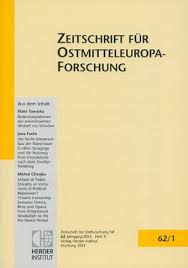Große Erzählungen oder dichte Beschreibungen: Vertreibungstopografien in der europäischen Geschichte
Grand Narratives or Thick Descriptions: Topographies of Displacement in European History
Author(s): Claudia KraftSubject(s): Political history, WW II and following years (1940 - 1949), Post-War period (1950 - 1989), Transformation Period (1990 - 2010), Migration Studies, Asylum, Refugees, Migration as Policy-fields
Published by: Verlag Herder-Institut
Keywords: Grand Narratives; Thick Descriptions; Topographies of Displacement; European History;
Summary/Abstract: The article discusses how mass displacement and forced migration during and after World War II is integrated into the writing of European history. It begins with a text by Hans Lemberg (first published in 1992) on “ethnic cleansing”, a concept that had become an influential explanatory tool for the understanding of the history of violence in 20th century Europe. Since then, various authors have developed the concept further and pointed to the close connection between nation-state-building and a longing for “ethnic purity”. A second interpretative current focuses on that part of the continent that has been affected most by mass displacement and murder, that is, Eastern and Central Europe, as a playground for the violent expansionism of National-Socialism and Stalinism. But both these “grand narratives” tend to ignore the specificities of these regions and the often inconsistent histories of both the victims and the victimizers. The article thus argues for a “thick description” of the Central and Eastern European theatre of war and displacement that takes into account the links between National-Socialist and Stalinist practices of occupation as well as the ties between war and post-war political arguments and practices. The focus on concrete places, such as on cities that were theatres of violence both before and after 1945, could help to develop a narrative that contributes to a better understanding of the discourses and practices of violence in Europe in the mid-20th century. And it could prevent an idealization of a “lost German East” unsuspectingly struck by violence “from outside”. Not only historiography but the popularization of knowledge about forced mass migration in museums could profit from such a shift that has its roots in Hans Lemberg’s analytical work.
Journal: Zeitschrift für Ostmitteleuropa-Forschung
- Issue Year: 63/2014
- Issue No: 1
- Page Range: 39-54
- Page Count: 16
- Language: German

